You'll Never Guess This Treadmill Incline Workout's Tricks
페이지 정보

본문
 How to Use a small space treadmill with incline Incline Workout
How to Use a small space treadmill with incline Incline WorkoutMany treadmills allow you to vary the incline of your exercise. Walking on a steep slope simulates walking uphill and burns more calories than flat-walking.
This is a low-impact exercise that could be a viable alternative to running for those with joint problems. It can be completed in a variety of speed and is easy to modify depending on your the fitness goals.
The right incline
No matter if you're a beginner on a treadmill or an experienced veteran the incline training method offers many opportunities to increase the intensity of your exercise routine. Incorporating incline on your treadmill will give you the feel of running outdoors without all the pounding on your joints. You'll burn more calories, increase endurance, strengthen your lower leg muscles, and increase your heartbeat by increasing the intensity of your runs or walks. You can easily incorporate incline-training into your cardio routine as part of a HIIT or steady-state workout.
When walking at an incline, be sure to take more steps and keep your arms pumped. A good rule of thumb is to tense your arms when you're walking at a 15-percent incline and relax them when you're at an incline of 1 percent. This will improve your form and prevent any injuries as you walk up hills. Be sure not to lean forward too much when climbing steeper hills, as this can strain your back.
If you're a novice to treadmill exercises with incline, it's a good idea to begin with a low incline and begin to work your way up. It's best to be able to comfortably walk for 30 minutes at a moderate pace on flat ground before trying any type of incline. This will help prevent injury and allow you to gradually increase your fitness level.
Most treadmills let you set an incline as you exercise. However, some do not allow you to alter the incline manually. In this case, you'll need to stop your workout and manually adjust the treadmill's deck to the desired incline setting. This can be a hassle and is not as convenient when you're doing an interval exercise where the incline changes every few minutes.
When you're doing a HIIT session, it's important to know the approximate maximum percentage of your maximum heart rate (HRmax). This will let you determine when you've reached your target heart rate and it is time to increase or decrease your speed. Similar to when you're performing a steady-state workout it is important to monitor your heart rate frequently throughout the workout and to keep it within the range of 80-90 percent of your maximum heart rate.
Warming up
Treadmill exercises are an effective way to burn calories but incline-based treadmills increase the intensity and provides additional benefits such as functional strength training. If you're brand new to running or walking on an inclined surface it is essential to warm up prior the intensity of your treadmill workout. This will help to reduce the risk of injury and also prepare your muscles for the challenging work ahead.
If you're new to the sport, starting your workout with two minutes of fast walking is a great way to begin your warm-up. Once you've warmed up, you can begin running. After your jog, you can add another two minutes of brisk walking to continue warming up your legs. You can then move onto a full body circuit that incorporates bodyweight exercises such as walking lunges and squats.
A full-body workout is excellent because it targets multiple muscle groups. It also helps build a stronger core. This is a great way to increase your heart rate, without pushing too hard on the treadmill. If you're unsure about the best workout to do, ask your fitness instructor for help.
Include an electric incline treadmill in your treadmill workout will provide the most realistic terrain for your exercise and also boost your VO2 max, which is the maximum amount of oxygen consumed. Walking on an inclined surface will train your muscles for walking on real-world terrain and will reduce the stress on your knees.
Treadmill incline exercises also target various leg muscle groups and are great for sculpting your lower body. Similar to walking at an angle will increase the range of motion in your arms, and increase the strength in your shoulders and chest muscles.
A high-intensity treadmill workout can be ideal for those who are just beginning and is suitable for those who wish to challenge themselves and achieve higher heart rates without the strain of exercising too hard. It is crucial to keep track of your heart rate during a high-intensity treadmill with incline uk workout, and be sure to stretch following the workout. Stretching can help relax tight muscles and recover your body from intense exercise.
Intervals
If you are using a treadmill for small spaces with incline for an incline workout, you want to increase the intensity using intervals. Interval training has been found to help burn calories while also building muscles quicker. It involves alternating intense exercise with periods of less intense exercise, like a walk or light jog. This type of exercise can aid in increasing your maximum oxygen consumption during exercise, or the VO2 max.
To get the most out of your treadmill incline workout you should include the two activities of walking and jogging. This will ensure that your body can recover between high-intensity intervals and avoid injuries. Warm up prior to starting the intervals.
Determine your desired heart rate prior to designing an incline treadmill exercise. This should be between 80-90 percent of the client's maximum heartbeat. You then can decide on the slope and speed to use for each interval.
You can create your own interval programs or use the built-in programs available on your treadmill. You can, for example, start with a 3-minute interval of jogging at a moderate pace and gradually increase the speed. Once you've reached your target heart rate, you can continue to jog at a comfortable pace for the remainder of the exercise.
For the next set, you can walk at an angle of 10 percent, and run for three to six repetitions. Then, you can return to the jog at a moderate pace for a minute of recovery. Repeat this exercise between five and eight times.
If you don't feel comfortable using a treadmill, consider a walking or running at an incline. This will test your balance and strengthen the muscles in your legs more than the treadmill. But, it's essential to examine your knees and ankles for any issues that may be underlying prior to attempting this kind of workout.
You can also include a variety of dumbbell exercises into your incline workout to increase the amount of muscle-building. For instance, you could perform lateral raises and dumbbell rows during your rest intervals to make the exercise more challenging.
Recovery
Most treadmills have an incline feature which lets you simulate walking uphill and running. You can alter the incline to make your workout more challenging or include intervals with greater intensity. This type of exercise is ideal for those who want to increase their cardio levels while burning calories without worrying about their joints.
In addition to burning more calories, incline walking engages different muscles in the body. This can strengthen the posterior chain which includes the hamstrings, glutes and the muscles of the calf. Inline treadmill walking can also work out the muscles that form your calves, like the peroneal muscles that are smaller and tibialis posterior muscles. This can increase the flexibility and strength of the muscles and is a good alternative to jogging if you are not comfortable with high-impact exercises.
If you're new to incline walking, start out with a low incline and gradually increase it over time. This will reduce joint pain and help you achieve your fitness goals quicker. It's crucial to listen to your body and stop exercising if you feel any pain or discomfort.
To get the most out of your incline workout it's important to start warming up for five minutes with level or gentle walking on an incline. Make sure to keep an eye at your heart rate throughout the exercise.
After your first interval, lower the gradient by 0% and walk for 3-4 minutes. This recovery phase assists in helping your heart rate return to normal and prepares your body for the next interval of incline.
 Repeat this procedure for the remainder of your training on an incline. Make sure to keep the work-to-rest ratio as close to 1:1 as you can. This allows you to increase the intensity of your exercise and get the desired results in a shorter amount of time. Stretch your muscles after working out to prevent tight muscles and issues with flexibility.
Repeat this procedure for the remainder of your training on an incline. Make sure to keep the work-to-rest ratio as close to 1:1 as you can. This allows you to increase the intensity of your exercise and get the desired results in a shorter amount of time. Stretch your muscles after working out to prevent tight muscles and issues with flexibility.- 이전글5 Killer Quora Answers On Treadmill For Sale 24.10.07
- 다음글Is There A Place To Research Private Psychiatrist Online Online 24.10.07
댓글목록
등록된 댓글이 없습니다.


